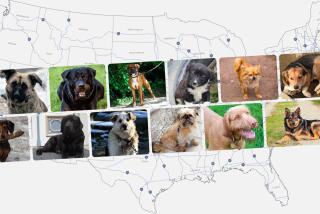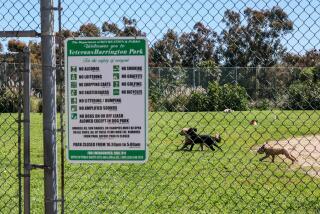Training Puppies for a Career of Aiding Others
With tails held high, the puppies in kelly-green jackets lunge at one another to sniff, wag and wrestle, dragging their handlers along.
As they wait for a bus, they jump and pant and tug at their leashes like any eager adolescent, but these are not just everyday hounds. Dodger, Limbo and Trotter may be young, even in dog years, but they are already in training to be guide dogs for blind people.
Their handlers are members of the South Bay puppy raisers’ group that met last week on a Torrance street corner to give their dogs a chance to get used to buses. The dogs practiced getting on and off a bus lent to the group by Torrance Transit, and learned to lie down at their masters’ feet. But mainly they learned not to be afraid of things rolling under the seats, the hissing of the doors or the smells of previous riders.
Each year Guide Dogs for the Blind, a private, nonprofit corporation, places about 600 German shepherd, and golden and Labrador retriever puppies in homes across the country to be nurtured and begin training.
Volunteers receive the puppies when they are 8 weeks old and return them when they are a year to 18 months old to the Guide Dogs center in the Northern California town of San Rafael.
Among the 15 South Bay puppy raisers is Betsy Topper, who works with Limbo, a 10-month-old cream-colored golden retriever. On a recent outing to the local farmers’ market, Limbo sniffed around, getting distracted by food on the ground when he was supposed to be heeling and watching where he was walking, Topper said. She kept working with him until he settled down.
She has no trouble getting Limbo into grocery stores. In her neighborhood, store employees were already used to guide dogs because customer Mary Alice Smith shops there regularly with the help of Jikaiah, a 3-year-old black Labrador.
Smith has used five guide dogs in the 23 years since she lost her sight because of glaucoma.
Her previous dog was a “conservative, Republican gentleman,” she said. But Jikaiah is a “teen-ager in a dog suit.”
But she trusts him completely. “You wouldn’t leave your house if you didn’t trust your dog,” she said. Smith credits the puppy raisers with making the difference in a guide dog.
“The person who raised him--that’s the important part,” Smith said. “It’s like a child’s first few years.”
About 15% of the puppy raisers are adults, but most of them, like Lisa Alvarez, 13, and her sister Talia, 11, come from 4-H clubs. Lisa is raising a golden retriever and Talia has a German shepherd.
Lisa decided she wanted to raise one of the dogs after she saw a puppy at the beach wearing the trademark green jacket that reads, “Guide Dog in Training,” said the girls’ mother, Joanie Alvarez. Lisa and Talia took classes to learn how to care for the puppies.
The children’s creativity helps in raising the dogs, Joanie Alvarez said. Showing the animals a windup toy, for example, helps them get over their fear of strange things.
Another 4-H club member, Marie Ellis, 13, is raising her second dog. Keith, her first puppy, is in training in San Rafael. Filbert, her current puppy, is a little more tentative than Keith, she said, but raising the second dog seems easier.
“It’s better when you have some more experience,” Marie said.
The South Bay puppy raisers and their dogs get together twice a month. Usually one meeting is devoted to obedience training and talking about dog raising. The other is an outing. Once they went to the airport and walked around on a jet. Another day they visited Santa Monica Pier. At Christmas, they go to a mall and get their pictures taken with Santa Claus.
The touring helps the dogs build confidence toward the day when a human will rely on their help to navigate in all kinds of places.
Guide Dogs pays for the dogs’ shots and veterinary costs, but officials estimate that it costs the volunteer family $300 to $500 for food and incidentals. The cost of breeding, raising and training the dogs, training the blind person, and then maintaining the dog during its lifetime is about $34,000. The blind person is not charged for the dog or services.
When dogs return to the Guide Dog center, they receive about five months of intensive training before being matched with a blind person. Then the two of them spend four weeks training together.
The puppy raiser is invited to the graduation to meet the dog’s new master.
Topper’s first puppy, Bounder, graduated and is working as a guide dog. But recently Topper had to return to the center to pick up Snyder, the second guide dog she raised: Snyder was disqualified because of repeated ear infections.
As happy as she was to see him again, Topper had mixed feelings about taking him back. “We work so hard at it--we really want them to graduate.”
More to Read
Sign up for Essential California
The most important California stories and recommendations in your inbox every morning.
You may occasionally receive promotional content from the Los Angeles Times.










